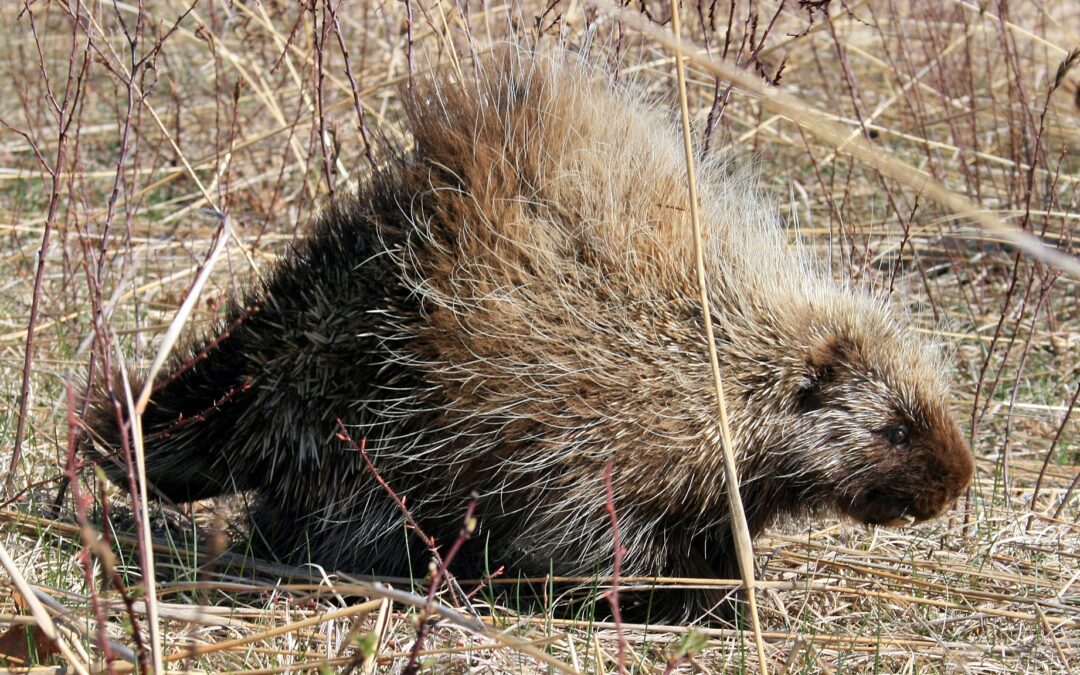The largest order of mammals belongs to the rodents. Rodents are known for their teeth or more specifically their gnawing. While they don’t have canine teeth, they have a single pair of incisor teeth in each jaw. These incisors never stop growing. The incisors have thick enamel layers on the front but not on the back; this causes them to retain their chisel shape as they are worn down.
Wisconsin’s 2nd largest rodent is the North American porcupine. Porcupines are distinguished by their modified hairs composed of keratin, or quills, that protect them from predation. Porcupines are found on all continents except Antarctica. There are two separate families of porcupines – Old World porcupines found in Europe, Asia and Africa and New World porcupines found in North, Central and South America. The North American porcupine can be found in most of Canada and the western United States south to Mexico. In the eastern United States, it can be found in Wisconsin, Michigan, Pennsylvania, New York and New England.
North American porcupines are found in the northern 2/3rds of Wisconsin and they have many unique characteristics. These porcupines are generally solitary animals and can be found in hardwood, conifer, and mixed forests. Porcupines are mostly nocturnal but can be seen feeding in tree crowns during the day. They are herbivores eating berries, leaves, needles, twigs, clover, roots, and acorns. Porcupines are also attracted to calcium found in animal bones and antlers, and salt. They have been known to gnaw on building siding, tool handles, and wooden fencing that have absorbed salts. They can gnaw on items that have absorbed sweat such as canoe paddle handles or axe handles.
Adults range from 2-3 feet long and weigh up to 30 pounds. They have poor eye sight and small ears but a great sense of smell. While their short legs make them slow on the ground, they have a special pebbly nonslip surface on their hairless foot pads which enable them to be great tree climbers.
Porcupines are very vocal during mating season. They mate in the fall and a single baby is born the next summer. Baby porcupines are called porcupettes. Porcupettes are born with soft quills which harden about an hour after being born. Porcupettes become independent at about six months.
Porcupines are covered by up to 30,000 modified hairs or quills composed of keratin. Just as animal hair is shed and replaced, so are the porcupine’s quills. New ones begin developing within a few days after the old ones are shed or removed. Quills can range from 1-4″ long. They use these to protect themselves from predators such as fishers, coyotes, great horned owls, wolves, and bobcats.
However, contrary to rumors, they cannot shoot or throw their quills. When a predator approaches, the porcupine will turn its back, raise the quills and lash out at the threat with its tail. Quills are loosely attached and dislodge at the slightest touch. If the porcupine hits an animal with its quills, the quills become embedded in the animal. The quills have a barbed end, this causes the quills to become further imbedded due to movement. Quills are mostly hollow and once embedded they absorb the injured animal’s heat and moisture causing them to swell. Quills should be removed by a doctor or veterinarian.
Native Americans used porcupine quills in the upper Midwest and Great Plains regions to create a variety of quillwork techniques. Quillwork is a type of embroidery using porcupine quills. Quills were dyed with mineral or vegetable dyes then worked into personalized designs. Prior to the 20th century, only women made decorative quillwork. Designs belonged to the woman who created them. The art form was thought to be sacred. Quillwork is very tedious and time consuming, and each quill must be attached to the background with a small stitch.
Porcupines do not hibernate but instead take shelter during severe winter weather in snags, under stumps, in culverts, rock crevices or caves. Winter can be a good time to see this slow-moving rodent. Porcupines leave a unique trail in the snow due to their dragging tail which tends to obliterate their foot prints. In the winter, they do not go very far from their shelters. Porcupines can damage or kill trees by sometimes focusing on a single tree and eating the bark on branches and boles leaving very visible white wood behind.

